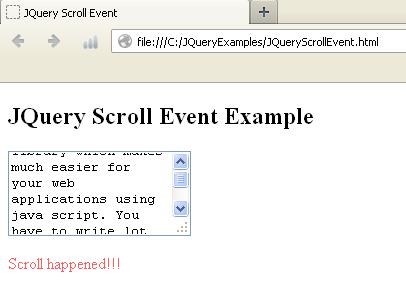The scroll event occurs when the user scrolls an element by using arrow keys, scroll bar or mouse wheel. We cannot prevent scrolling. When user scrolls to different place in the element, the scroll event is sent to an element. It is sent whenever the element’s scroll position changes. The scroll() event also occurs when browser window is scrolled and when scrollable elements like textarea are scrolled. The scroll() event attaches a function which is to be run when a scroll event occurs.
JQuery Scroll() Syntax
$(selector).scroll(function)
It has parameter called function which specifies the function to be run when scroll event occurs.
JQuery Scroll() Example
<!doctype html>
<head>
<title>JQuery Scroll Event</title>
<script src="http://code.jquery.com/jquery-1.11.0.min.js"></script>
</head>
<h2>JQuery Scroll Event Example</h2>
<style>
span {
color: red;
display: none;
}
</style>
<script type="text/javascript">
$(document).ready(function(){
$("#txtscroll").scroll(function(){
$( "span" ).css( "display", "inline" ).fadeOut( "slow" );
});
});
</script>
<body>
<textarea rows="4" cols="20" id="txtscroll">
JQuery is a JavaScript based library which makes much easier for your web applications using java script. You have to write lot of code to accomplish tasks in java script but jQuery enables you to write much less code. So the jQuery is light weight, “write less, do more”, JavaScript library specialized for changing the web page documents on the fly. It makes much easier to use JavaScript on your web site. JQuery makes quite simple, like HTML document traversal and manipulation, handling events such as clicking on links, mouse events etc, animations for applications etc.
</textarea>
<p><span>Scroll happened!!!</span></p>
</body>
</html>
- As shown in the above program, we have used the code inside $(document).ready which is an event which fires up when document is ready. It will run once the page document object model is ready for JavaScript code to execute.
- $(“#txtscroll”).scroll(function()) line defines scroll function which is to be run when a scroll event occurs and uses id selector txtscroll of textarea component.
- $( “span” ).css( “display”, “inline” ).fadeOut( “slow” ); line uses CSS properties to display the line in style format and fadeout() method defines fading effect from visible to hidden for selected elements and specifies the speed of the fading effect.
- The text area defines multi line input control. It can hold unlimited number of characters and text in the fixed width font. The size of text area can be specified by rows and columns attributes.
- After executing the program, you will get textarea in the browser with specified messages. When scroll each time in the textarea, you will be getting Scroll happened!!! line in the browser.
JQuery Scroll Event Demo
When you run the above example, you would get the following output :


 How To Get Class Loaded Path
How To Get Class Loaded Path